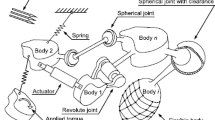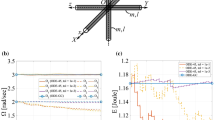Abstract
An approach is proposed for modeling and analyses of rigid multibody systems with frictional translation joints and driving constraints. The geometric constraints of translational joints with small clearance are treated as bilateral constraints by neglecting the impact between sliders and guides. Firstly, the normal forces acting on sliders, the driving constraint forces (or moments) and the constraint forces of smooth revolute joints are all described by complementary conditions. The frictional contacts are characterized by a setvalued force law of Coulomb’s dry friction. Combined with the theory of the horizontal linear complementarity problem (HLCP), an event-driven scheme is used to detect the transitions of the contact situation between sliders and guides, and the stick-slip transitions of sliders, respectively. And then, all constraint forces in the system can be computed easily. Secondly, the dynamic equations of multibody systems are written at the acceleration-force level by the Lagrange multiplier technique, and the Baumgarte stabilization method is used to reduce the constraint drift. Finally, a numerical example is given to show some non-smooth dynamical behaviors of the studied system. The obtained results validate the feasibility of algorithm and the effect of constraint stabilization.
Similar content being viewed by others
References
Flores, P., Ambrósio, J.: Revolute joints with clearance in multibody systems. Comput. Struct. 82, 1359–1369 (2004)
Flores, P., Ambrósio, J., Claro, J.C.P., et al.: Kinematics and dynamics of multibody systems with imperfect joints: Models and case studies. Lecture Notes in Applied and Computational Mechanics, Volumn 34. Springer, Berlin (2008)
Tian, Q., Zhang, Y., Chen, L., et al.: Dynamics of spatial flexible multibody systems with clearance and lubricated spherical joints. Comput. Struct. 87, 913–929 (2009)
Liu, C.S., Zhang, K., Yang, R.: The FEManalysis and approximate model for cylindrical joints with clearances. Mech. Mach. Theory. 42, 183–197 (2007)
Crowthera, A.R., Singha, R., Zhangb, N., et al.: Impulsive response of an automatic transmission system with multiple clearances: Formulation, simulation and experiment. J. Sound Vib. 306, 444–466 (2007)
Flores, P., Ambrósio, J., Claro, J.P.: Dynamic analysis for planar multibody mechanical systems with lubricated joints. Multibody Syst. Dyn. 12, 47–74 (2004)
Erkaya, S., Uzmay, I.: A neural-genetic (NN-GA) approach for optimising mechanisms having joints with clearance. Multibody Syst. Dyn. 20, 69–83 (2008)
Flores, P.: Modeling and simulation of wear in revolute clearance joints in multibody systems. Mech. Mach. Theory 44, 1211–1222 (2009)
Flores, P., Ambrósio, J., Claro, J.C.P., et al.: Translational joints with clearance in rigid multibody systems. J. Comput. Nonlinear Dyn. 3, 0110071–10 (2008)
Awrejcewicz, J., Kudra, G., Lamarque, C.H.: Dynamics investigation of three coupled rods with horizontal barrier. Meccanica 38, 687–698 (2003)
Stoenescu, E.D., Marghitu, D.B.: Dynamic analysis of a planar rigid-link mechanism with rotating slider joint and clearance. J. Sound Vib. 266, 394–404 (2003)
Pfeiffer, F.: The idea of complementarity in multibody dynamics. Archive of Applied Mechanics 72, 807–816 (2003)
Pfeiffer, F., Glocker, C.: Multibody Dynamics with Unilateral Contacts. John Wiley & Sons, New York (1996)
Brogliato, B., Ten Dam, A.A., Paoli, L., et al.: Numerical simulations of finite dimensional multibody nonsmooth mechanical systems. Applied Mechanics Reviews 55, 107–150 (2002)
Glocker, C., Pfeiffer, F.: Complementarity problems in multibody systems with planar friction. Arch. Appl. Mech. 63, 452–463 (1993)
Flores, P., Leine, R., Glocker, C.: Modeling and analysis of planar rigid multibody systems with translational clearance joints based on the non-smooth dynamics approach. Multibody Syst. Dyn. 23, 165–190 (2010)
Anitescu, M., Hart, G.D.: A constraint-stabilized time-stepping approach for rigid multibody dynamics with joints, contact and friction. Int. J. Numer. Meth. Engng. 60, 2335–2371 (2004)
Neto, M.A., Ambrósio, J.: Stabilization methods for the integration of DAE in the presence of redundant constraints. Multibody Syst. Dyn. 10, 81–105 (2003)
Flores, P., Machado, M., Seabra, E., et al.: A parametric study on the Baumgarte stabilization method for forward dynamics of constrained multibody systems. J. Comput. Nonlinear Dyn. 6, 011019 (2011)
Blajer, W.: Methods for constraint violation suppression in the numerical simulation of constrained multibody systems—A comparative study. Comput. Methods Appl. Mech. Engrg. 200, 1568–1576 (2011)
Lin, S.T., Hong, M.C.: Stabilization method for numerical integration of multibody mechanical systems. Journal of Mechanical Design, 120, 565–572 (1998)
Hamel, G.: Theoretische Mechanik. Springer-Verlag, Berlin. 543–549, 629–639 (1967) (in Germany)
Klepp, H.J.: The existence and uniqueness of solutions for a single-degree-of-freedom system with two friction-affected sliding joints. J. Sound Vib. 185, 364–371 (1995)
Wang, Q., Peng, H., Zhuang, F.: A constraint-stabilized method for multibody dynamics with friction-affected translational joints based on HLCP. Discrete Continuous Dyn. Syst. Ser. B 16, 589–605 (2011)
Dupont, P.E.: The effect of Coulomb friction on the existence and uniqueness of the forward dynamics problem. Proceedings of the 1992 IEEE International Conference on Robotics and Automation, Nice, France, May 1992, 1442–1447 (1992)
Klepp, H.J.: Trial-and-error based method for the investigation of multibody systems with friction. J. Sound Vib. 197, 629–637 (1996)
David, M.T., Henry, R.B.: Investigation of a method for the three-dimensional rigid body dynamics inverse problem. Multibody Syst. Dyn. 27, 423–435 (2012)
Staicu, S.: Matrix modeling of inverse dynamics of spatial and planar parallel robots. Multibody Syst. Dyn. 27, 239–265 (2012)
Aghili, F.: A unified approach for inverse and direct dynamics of constrained multibody systems based on linear projection operator: Applications to control and simulation. IEEE Transactions on Robotics 21, 834–849 (2005)
Carlo, L.B., Alessandro, C., Luca, G., et al.: On the solution of inverse dynamics and trajectory optimization problems for multibody systems. Multibody System Dynamics 11, 1–22 (2004)
Zhuang, F., Wang, Q.: Modeling and simulation of the nonsmooth planar rigid multibody systems with frictional translational joints. Multibody Syst. Dyn. 29, 403–423 (2013)
Leine, R.I., Van Campen, D.H., Glocker, C.: Nonlinear dynamics and modeling of various wooden toys with impact and friction. J. Sound Control 9, 25–78 (2003)
Blajer, W.: On the determination of joint reactions in multibody mechanisms. Journal of Mechanical Design 126, 341–350 (2004)
Baumgarte, J.: Stabilization of constraints and integrals of motion in dynamical systems. Comput. Methods Appl. Mech. Engrg. 1, 1–16 (1972)
Braun, D.J., Goldfarb, M.: Eliminating constraint drift in the numerical simulation of constrained dynamical systems. Comput. Methods Appl. Mech. Engrg. 198, 3151–3160 (2009)
Schäfer, U.: Verification methods for the horizontal linear complementarity problem. Proc. Appl. Math. Mech. 8, 10799–10800 (2008)
Lemke, C.E.: Some pivot schemes for the linear complementarity problem. Math. Program. Stud. 7, 15–35 (1978)
Cottle, R.W., Pang, J.S., Stone, R.E.: The Linear Complementarity Problem. Academic Press, Boston (1992)
Author information
Authors and Affiliations
Corresponding author
Additional information
The project is supported by the National Natural Science Foundation of China (11372018 and 11172019).
Rights and permissions
About this article
Cite this article
Zhuang, FF., Wang, Q. Modeling and analysis of rigid multibody systems with driving constraints and frictional translation joints. Acta Mech Sin 30, 437–446 (2014). https://doi.org/10.1007/s10409-014-0021-1
Received:
Revised:
Accepted:
Published:
Issue Date:
DOI: https://doi.org/10.1007/s10409-014-0021-1




